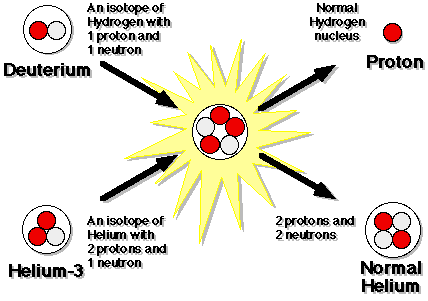Helium-3 Deuterium
A goal of the scientists behind fusion reactor technology is to find a safe fuel that does not cause the deterioration of the surrounding surfaces which unfortunately deuterium-tritium reactions do, due to the free neutron that is shot out from their nuclear reaction. There is a nuclear reaction which results in a more or less perfect reaction, one in which there is no neutron that is released as a result of the fusion. This reaction involves Helium-3 and Deuterium; as mentioned before, Deuterium is a naturally occurring isotope of hydrogen and is abundant in the water of the ocean, however Helium-3 is not nearly as common on Earth, and in fact makes up a very small portion of the helium on Earth as it is a byproduct of maintenance done on nuclear weapons and apparently there is only about 29 kg total in the U.S. reserves. While it is true that there is very little He-3 found on Earth, an idea has surfaced that may have miners no longer digging in the ground on Earth, but rather digging in the ground on the Moon! The moon actually has an estimated 1,100,000 metric tonnes of He-3 that if combined with equal amounts of deuterium would result in 20,000 terra-watt years. To put this into perspective, a page written by the Artemis Society International states that this would be the equivalent of burning 10 times the total amount of fossil fuels available on Earth or using every bit of uranium we would ever find and we still only get about half the amount of energy with an amount of radioactive waste that would be impossible to deal with. Below is a picture of the Helium-3 Deuterium reaction:
